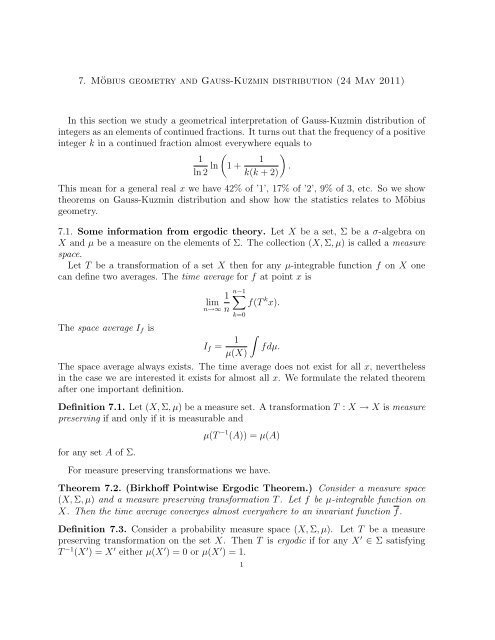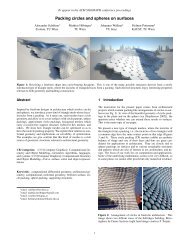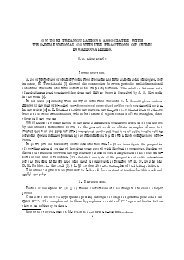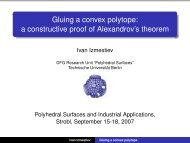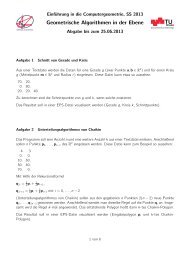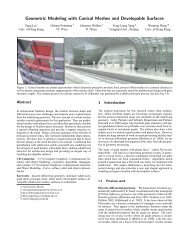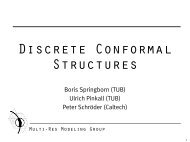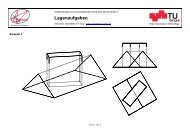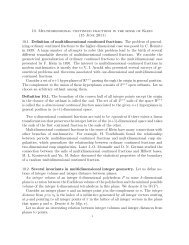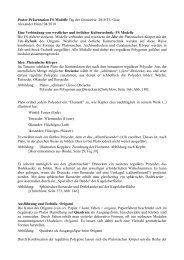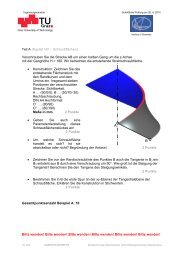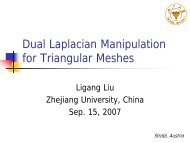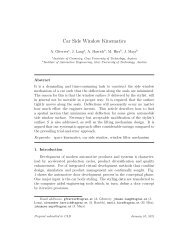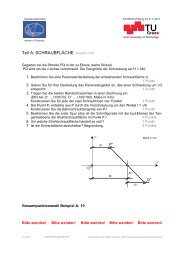Moebius geometry and Gauss-Kuzmin distribution (pdf)
Moebius geometry and Gauss-Kuzmin distribution (pdf)
Moebius geometry and Gauss-Kuzmin distribution (pdf)
Create successful ePaper yourself
Turn your PDF publications into a flip-book with our unique Google optimized e-Paper software.
10continued fractions manifold one should: take p −1 (F ); calculate Möbius measure of theobtained set of the manifold of framed continued fractions; divide the result by 2.7.9. Explicit formulae for the Möbius form. Let us write down Möbius forms of theframed one-dimensional continued fractions manifold F CF 1 explicitly in special charts.Consider a vector space R 2 equipped with st<strong>and</strong>ard metrics on it. Let l be an arbitrarystraight line in R 2 that does not pass through the origin, let us choose some Euclideancoordinates O l X l on it. Denote by F CF 1,l a chart of the manifold F CF 1 that consistsof all ordered pairs of straight lines both intersecting l. Let us associate to any point ofF CF 1,l (i. e. to a collection of two straight lines) coordinates (x l , y l ), where x l <strong>and</strong> y lare the coordinates on l for the intersections of l with the first <strong>and</strong> the second straightlines of the collection respectively. Denote by |v| l the Euclidean length of a vector v inthe coordinates O l X l Y l of the chart F CF 1,l . Note that the chart F CF 1,l is a space R × Rminus its diagonal.Consider the following form in the chart F CF 1,l :ω l (x l , y l ) = dx l ∧ dy l.|x l − y l | 2 lcoincides with the restriction of some Möbius mea-Proposition 7.22. The measure µ ωlsures to F CF 1,l .Proof. Any transformation of the group P GL(2, R) is in the one-to-one correspondencewith the set of all projective transformations of the straight line l projectivization. Notethat the expression∆x l ∆y l|x l − y l | 2 lis an infinitesimal cross-ratio of four point with coordinates x l , y l , x l +∆x l <strong>and</strong> y l +∆y l .Hence the form ω l (x l , y l ) is invariant for the action of transformations (of the everywheredense set) of the chart F CF 1,l , that are induced by projective transformations ofl. Therefore, the measure µ ωl coincides with the restriction of some Möbius measures toF CF 1,l .□Corollary 7.23. A restriction of an arbitrary Möbius measure to the chart F CF 1,l isproportional to µ ωl .Proof. The statement follows from the proportionality of any two Möbius measures.□Consider now the manifold F CF 1 as a set of ordered pairs of distinct points on acircle R/πZ (this circle is a one-dimensional projective space obtained from unit circleby identifying antipodal points). The doubled angular coordinate ϕ of the circle R/πZinducing by the coordinate x of straight line R naturally defines the coordinates (ϕ 1 , ϕ 2 )of the manifold F CF 1 .
11−10 kk + 1lFigure 2. Rays defining a continued fraction should lie in the domaincolored in gray.Proposition 7.24. The form ω l (x l , y l ) is extendable to some form ω 1 of F CF 1 . In coordinates(ϕ 1 , ϕ 2 ) the form ω 1 can be written as follows:ω 1 = 1 ( )ϕ1 − ϕ 24 cot2 dϕ 1 ∧ dϕ 2 .2We leave a proof of Proposition 7.24 as an exercise for the reader.7.10. Relative frequencies of faces of one-dimensional continued fractions. Withoutloose of generality in this subsection we consider only Möbius form ω 1 of Proposition7.24. Denote the natural projection of the form µ ω1 to the manifold of one-dimensionalcontinued fractions CF 1 by µ 1 .Consider an arbitrary segment F with vertices at integer points. Denote by CF 1 (F )the set of continued fractions that contain the segment F as a face.Definition 7.25. The quantity µ 1 (CF 1 (F )) is called relative frequency of the face F .Note that the relative frequencies of faces of the same integer-linear type are equivalent.Any face of one-dimensional continued fraction is at unit integer distance from the origin.Thus, integer-linear type of a face is defined by its integer length (the number of innerinteger points plus unity). Denote the relative frequency of the edge of integer length kby µ 1 ( ′′ k ′′ ).Proposition 7.26. For any positive integer k the following holds:()µ 1 ( ′′ k ′′ 1) = ln 1 + .k(k + 2)Proof. Consider a particular representative of an integer-linear type of the length k segment:the segment with vertices (0, 1) <strong>and</strong> (k, 1). One-dimensional continued fractioncontains the segment as a face iff one of the straight lines defining the fraction intersectsthe interval with vertices (−1, 1) <strong>and</strong> (0, 1) while the other straight line intersects theinterval with vertices (k, 1) <strong>and</strong> (k+1, 1), see on Figure 2.For the straight line l defined by the equation y = 1 we calculate the Möbius measureof Cartesian product of the described couple of intervals. By the last subsection it follows
12that this quantity coincides with relative frequency µ 1 ( ′′ k ′′ ). So,∫ 0 ∫k+1∫k+1( µ 1 ( ′′ k ′′ dx l dy l 1) =(x l − y l ) = − 1 )dy 2 l =y l y l + 1( −1 k ) ( k )(k + 1)(k + 1)1ln= ln 1 + .k(k + 2)k(k + 2)This proves the proposition.Remark 7.27. Note that the argument of the logarithm (k+1)(k+1)k(k+2)(−1, 1), (0, 1), (k, 1), <strong>and</strong> (k+1, 1).Corollary 7.28. Relative frequency µ 1 ( ′′ k ′′ ) up to the factorln 2 =∫ 0−1∫+∞1dx l dy l(x l − y l ) 2□is a cross-ratio of pointscoincides with <strong>Gauss</strong>-<strong>Kuzmin</strong> frequency P (k) for k to be an element of continued fraction.□[1] (a) Prove that the measureExercises.µ(S) = 1 ∫ln 2Sdx1 + xis a probability measure on a segment [0, 1], i.e., µ([0, 1]) = 1.(b) Find µ([a, b]) for 0 ≤ a < b ≤ 1, where µ is as above.[2] Ergodicity of the doubling map. Consider a space (S 1 , Σ, λ), where X is a unitecircle, Σ is a Borel σ-algebra, <strong>and</strong> λ is a Lebesgue measure. Consider the doubling mapT : S 1 → S 1 such thatT (ϕ) = 2ϕ.Prove that T is measure preserving <strong>and</strong> ergodic.[3] Define the frequencies of subsequences in continued fractions. What is the frequency ofthe sequence (1, 2, 3).[4] Prove ˆµ-density theorem from Lebesgue density theorem.[5] Recall that Ψ 0 is a subset irrational numbers in [0, 1] whose continued fractions do notcontain ’1’ element. Prove elementary (without using ergodic theorems) thatˆµ(Ψ 0 ) = 0.[6] Prove the projective invariance of cross-ratio <strong>and</strong> infinitesimal cross-ratio.[7] Prove that RP 1 is homeomorphic to a circle. Prove that CF 1 is homeomorphic to Möbiusb<strong>and</strong>.[8] Prove Proposition 7.24.E-mail address, Oleg Karpenkov: karpenkov@tugraz.atTU Graz /Kopernikusgasse 24, A 8010 Graz, Austria/


